What's Wrong With Selly Manor?
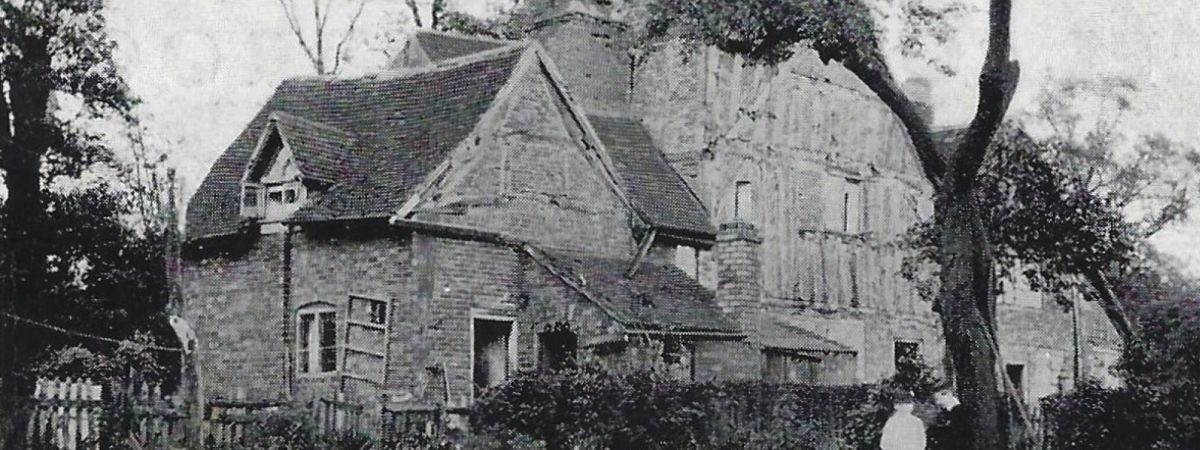
Share
The two buildings which form Selly Manor Museum (also known as Smythe's Tenement or The Rookery and Minworth Greaves) are two of the oldest buildings in Birmingham. But the story of their transfer to their current location and restoration in 1912 - 1916 and 1931 - 1932 respectively, is also a snapshot of the history of building conservation, a time when conservation methods were not as developed as they are now.
The century before had been marked by restorations of mediaeval buildings which had no hesitation in 'restoring' them to how people thought they would have looked regardless of their history. William Morris, one of the founders of The Society for the Protection of Ancient Buildings (SPAB) was very critical of these restorations in a talk given in 1877:
'But of late years a great uprising of ecclesiastical zeal, coinciding with a great increase of study, and consequently of knowledge of mediaeval architecture, has driven people into spending their money on these buildings, not merely with the purpose of repairing them, of keeping them safe, clean, and wind and water-tight, but also of "restoring" them to some ideal state of perfection; sweeping away if possible all signs of what has befallen them at least since the Reformation, and often since dates much earlier...'
The Rookery, which was in the manor of Selly, was certainly recognised as very old, and concerns had already been raised about its survival before George Cadbury bought it at auction. Edward Oliveri, the then owner had been reluctantly persuaded to carry out as few repairs as he could to keep it standing rather than demolish the house as he had intended, before 1897. A photograph dated 1897 shows that the chimneys had been pointed in lime mortar and some new infilling panels had been inserted. However at the time George Cadbury bought the building the additions and improvements over several centuries remained in situ and the building remained on its original site. Cadbury and his architect were therefore faced with the twin dilemmas of having to preserve the building and making decisions about the changes made to the building since it was built.
At this time there was no statutory listing to preserve ancient buildings, and therefore there was no legal means to stop George Cadbury moving, altering, or even demolishing, his property. The Ancient Monuments Protection Act of 1882 established a schedule of prehistoric monuments, but it was only with the Town and Country Planning Acts of 1944 and 1947 that this protection was extended, and only to pre-1750 buildings. Both buildings were only listed on 25th April 1952 so until then had no legal protection at all.
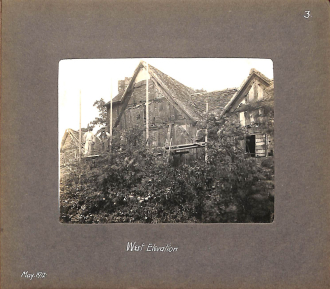
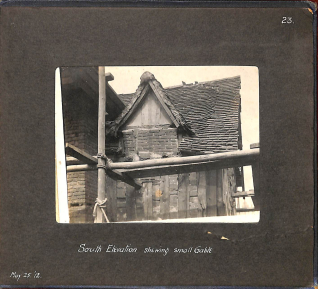
Images: Taken from architect William Alexander Harvey's own photographic record, these images show the dire state Selly Manor was in when it was purchased by George Cadbury. At this stage the building was being surveyed and the first scaffold poles can be seen prior to dismantling.
The whole process of dismantling and rebuilding was recorded in a series of photographs which are by turns horrifying, puzzling and fascinating. They show the poor condition of the house in the early 1900s, and the fascinating process of dismantling and re-erection in Bournville, and incidentally leave the viewer in no doubt that without George Cadbury's intervention The Rookery would certainly have been lost, either by neglect or deliberate demolition. But what is most noticeable is that on many of the 'before' pictures it is impossible to recognise the house, even with a familiarity with it. The general shape and much of the externals are as they are now, however there are more additions outside and there are differences in the infilling between the timbers and windows. The internal pictures are the most surprising and in many of them there is no indication that the house is the same one. We see pictures of Victorian kitchens with ranges, and when you stop wondering why this picture has been included you realise that you are looking at the dining room of The Rookery, with the fireplace very different to how it is now.
There are pictures of bedrooms with flowery Victorian wallpaper which could literally be anywhere, and a particularly puzzling picture of a bare brick internal wall with a metal window, which looks like the interior of any Victorian factory and is certainly nowhere to be seen on the Selly Manor site today. Looking at these pictures it is clear that the building we have today is very different from the house George Cadbury bought in 1907 and some difficult decisions have been made by members of the Cadbury family and their architect William Alexander Harvey.
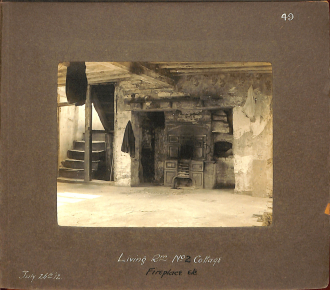
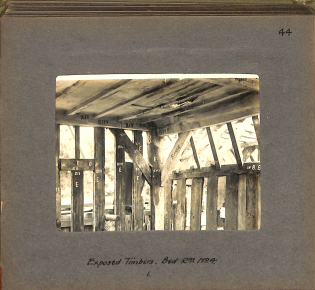
Images: Internal shots from Harvey's records show firstly some of the later additions to the building, including a large Victorian range. The second image shows the methodical markings that were made to record the place of each timber.
There have been two main criticisms of the treatment of the two buildings: the simple fact of moving them at all, and the way they have been reconstructed to fit in with the Tudor and Mediaeval periods, with a loss of the buildings' subsequent history.
When the SPAB heard that George Cadbury had bought the house said to be the manor of Selly, their Secretary, architect Hugh Thackeray Turner, wrote to him on 17th January 1908 enthusiastically appreciating his generosity in saving the building, offering their advice and support free of charge to restore it and save it but cautioning:
'It understands that the house is situated in a locality which is the reverse of picturesque, and that there has been a suggestion to remove the building to a more suitable neighbourhood. The Committee fully appreciates the reasons set forth for treating the building in this way, but it would venture to express a hope that the proposal will not be entertained, for ancient buildings which are removed from their original sites, in its opinion, lose a great part of their interest, and the Committee feels that a better course would be to try to improve the surroundings, rather than to attempt to remove the buildings to better surroundings.'
When Cadbury told them that a definite decision had been made to move the Rookery, Thackeray wrote back to say that as a result they would no longer feel it necessary to advise:
'[...] the Committee feels that no good would result from a professional member visiting the Manor House [to offer advice as previously suggested], for in its opinion the vital interest of the building would be lost in the process of removal and rebuilding.'
The view of the SPAB is the one which is current in conservation today, that the building should be kept in situ and a judgement made on the basis of heritage values of evidential value, historical value, aesthetic value and communal value. Considered in the light of these values, the moving and reconstruction of The Rookery and Minworth Greaves lost a lot of the evidential value of how people lived in the buildings and the communal value of the people who lived here. For example we know that The Rookery was considerably altered over its long life, and changes made in the nineteenth century would now seem to us historic in a way they didn't to George Cadbury. However the reconstruction of the buildings does mean that they continue to yield historical value (our shared experience of how things happened in the past) and aesthetic value (the conscious design of a place): the buildings at Selly Manor retain their ability to create a strong emotional or intellectual reaction in everyone who visits, as was the intention.
While it may now seem reckless to ignore the advice of the Society for the Protection of Ancient Buildings, their opinion was not the only opinion at the time of how old buildings could be treated and it has not been unusual to move old buildings from one site to another, often museums. Around this time (in 1911) another old Birmingham timber-framed building, The Golden Lion Inn, was similarly dismantled and moved from its original site in Digbeth for re-erection in Cannon Hill Park.
The other criticism of the moving and rebuilding of The Rookery and Minworth Greaves has been in the way they have been reconstructed with a loss of some original material and subsequent alterations. Among the things which you wouldn't dream of doing to a Tudor and Mediaeval building now are:
- The Rookery stood on its original stone foundations in Bournbrook, but had to be built on new foundations to allow for a wet site in Bournville (the new location was a former pond);
- later brick infill between the timbers, later brick external walls, much of the infill plaster, brickwork of chimneys, external additions such as lean-tos, later internal partitions, fixtures and fittings such as doors and their furniture, were all lost;
- the external staircase was not in situ in 1908 but was constructed anew because there had been one listed in a description of the house in the fifteenth century;
- repairs to the timbers were made with other old timbers collected from other buildings by the architect, which complicates the historical picture (Laurence Cadbury recalled spending weekends in 1912 trekking through builders' yards with W. Alexander Harvey looking for building materials - although it was on one of those trips that they came across Minworth Greaves);
- Minworth Greaves was restored to the shape of a mediaeval hall, and subsequent additions removed.
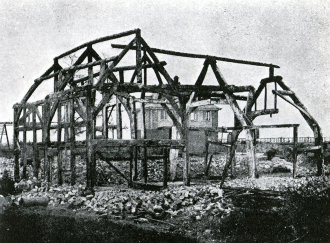
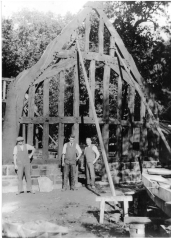
Images: On the left the timber construction of Minworth Greaves shows what was purchased. Only the rear section was reconstructed in Bournville. The second image shows the rebuilding process in 1932.
In his history of The Rookery, George Demidowicz concluded that a comprehensive study of the albums would still need to be undertaken to determine what proportion of the original building made its way to Bournville and what proportion was lost. It should be stressed that while the reconstruction of the buildings lost much that would now be considered historically important, other examples of this type of reconstruction at the time show that it was not very unusual, and in the reconstruction no major timber of the frame was lost.
There was also the problem that at the time The Rookery was reconstructed there was a lack of craftsmen and the specialist heritage firms that would be used today, so the work was done by masons from the Tamworth firm of Mitchell. Some of the techniques used were also problematic, for example the spaces were infilled between the timbers with either plastered ceramic tile or the lath and plaster known to every owner of a Victorian house, rather than the wattle and daub that would have been used originally, or the extensive brick infill used before reconstruction. This has the problem that the infill does not move as much as the timber frame naturally does, leading to the infill cracking and breaking away. Extensive repairs were made to The Rookery in 2018 using lime plaster which provides flexibility as the timbers expand and contract.
The buildings at Selly Manor Museum are therefore not just a museum of two of Birmingham's oldest buildings but a history of a particular time in Britain's building conservation. Following modern heritage values, future conservation at the site will mean including this history as something to be conserved.
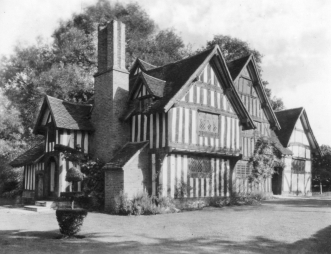
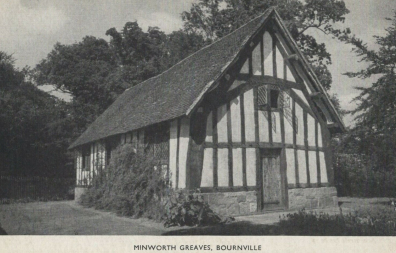
Images: Selly Manor (left) in the 1920s and Minworth Greaves (right) in the 1930s, shortly after each building was completed in their new home of Bournville.
The question of what would have happened to the buildings without the Cadbury family's intervention to maintain them is a difficult one to answer. The fate of both buildings depended on chance intervention of people willing to save them and also having the resources to do so (by 1916 the project had cost the Cadburys £6,000 - approximately £353,953 in 2017 values) at a time when The Rookery was on land wanted for redevelopment.
The survival of Minworth Greaves depended on the chance finding and purchase of the building and it would not have been saved if George Cadbury hadn't wanted to reconstruct The Rookery. Would a purchase by an unsympathetic buyer in 1907 have automatically ended in the house being demolished for new housing? Could the burgeoning local interest in The Rookery have led to the development of alternative plans to save it such as public collections, forming a trust a buy it, intervention by the council, moving it to a public place (exactly what happened to The Golden Lion in Digbeth)? Could people more sympathetic to the SPAB's view have somehow bought the house and done a more sympathetic restoration on its original site? Minworth Greaves was saved by its chance discovery during a trip to find materials for the restoration for the Rookery and without this chance its possible fate raises the same questions.
Since the same variables of volition and resources influence the fate of historic buildings today, it is also interesting to compare what might have happened to them if the same circumstances of a historic building standing neglected on valuable building land occurred again. Probably both would have been listed by now. This would alter the variables slightly, since it would make demolition illegal. However would this stop a programme of determined neglect and chance break ins and fires, overseen by a determined owner?
John Berry
Selly Manor Museum Volunteer
Sources:
Selly Manor Museum Guidebook (Bournville Village Trust, no date).
William Morris: The Lesser Arts. Chapter 1 of Hopes and Fears for Art. https://www.marxists.org/archive/morris/works/1882/hopes/chapters/chapter1.htm
George Demidowicz: 'Selly Manor' A New History. For the Selly Manor Museum, Bournville Village Trust, 2012.
Historic England: About the List. https://historicengland.org.uk/listing/the-list/about-the-list/
Historic England: Selly Manor (List Entry Number 1076129). https://historicengland.org.uk/listing/the-list/list-entry/1076129
Historic England: Minworth Greaves (List Entry Number 1343157). https://historicengland.org.uk/listing/the-list/list-entry/1343157
Selly Manor Archives: photo albums of the buildings in situ and reconstruction at Bournville; letter from Thackeray Turner to George Cadbury 17th January, 1908; letter from Thackeray Turner to George Cadbury 24th January, 1908; Memo dated September 1937: 'Selly Manor - Sub-Manor of Weoley'.
Historic England: Conservation Principles, Policies and Guidance.English Heritage, London, 2008.
Anecdotal information from Bournville Village Trust Heritage Manager Daniel Callicott.
National Archives Currency Converter. https://www.nationalarchives.gov.uk/currency-converter/